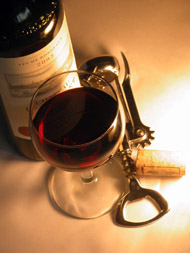Home Page>Become A Wine Snob
Secrets to Becoming a Wine Connoisseur
by Fred London
Wine is a broad term that refers to the fermentation of plant matter for the purpose of producing an alcoholic beverage. Of course, most people think of grapes as the basis for wine, but other sources include rice (sake), various fruits (elderberry, grapefruit, cherry, etc.), barley, and even honey (mead).
For the purposes of this short explanation, we ll stick with wines made from grapes. These are categorized several ways, including by vinification methods, taste, and vintage. Many casual drinkers pay little attention to the differences in these categories. After all, for most folks the sole consideration is good taste. However, for many aficionados wine is serious business. The variety, taste, and vintage must all meet high expectations before serious collectors will consider owning a bottle.
Vinification
Vinification simply means the method by which grape juice is fermented into wine. The practices followed during fermentation are what determine the type of wine you end up being able to purchase. A common misunderstanding by the average drinker is that grape juice colors vary, which is what produces red, white, or rose wines. Actually, all grapes produce clear (or very close to clear) juices. What creates the color of the wine you buy is whether the grape skins have been left in contact with the juice during the fermentation process. Red wines have been fermented thusly; whites have not fermented in contact with grape skins; rose is a combination of the two.
Sparkling wines, such as champagne, have bubbly characteristics that are caused by the addition of carbon dioxide. This effect is achieved by fermenting the grape juice two times. The first time, the juice is fermented in open containers, which allow the carbon dioxide to escape. During the second fermentation, the juice is kept in closed containers, trapping and infusing the gases.
Taste
Most wines are described as dry, off-dry, fruity, or sweet. Technically, this refers to the amount of sugars left over after fermentation is completed. Dry has a tiny amount of residual sugar content, while sweet has high sugar content.
Beyond this basic taste classification, wine-tasting experts have developed a system of classifying wines by the more in-depth tastes and aromas they exude. Many outsiders find this a somewhat bewildering system, but tasting pros consider the ability to discern subtle elements of a wines taste to be a badge of honor. As one example, Cabernet Sauvignon is a popular variety that wine tasters claim contains a combination of black currants, chocolate, mint, and tobacco flavors.
Vintage
Vintage is a straightforward classification. It refers to the year of the grapes harvest from which a bottle of wine was made. This is important because many grape growers have exceptionally good harvests only during certain years. Also, the best grapes are usually singled out for use in a producers vintage bottles. You get the highest quality wine from that year’s harvest.
Fred London, internationally acclaimed wine connoisseur, knows that proper wine storage is key to the best taste in wines. Get the information you need to keep your wines at their finest, check out Fred's wine resource center http://www.AboutWineRefrigerators.com.
Article Source: Article Dashboard

Bookmark Us:







